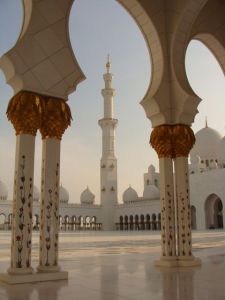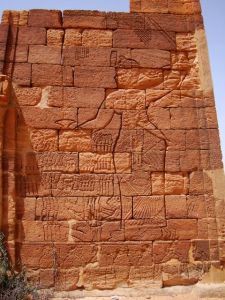When two powerful but rather mutually exclusive cultures come into contact (and here I’m not talking about West/East in the present day), strange things happen between their languages. In one of my courses this semester I am studying the power dynamics of such linguistic interplay. But this particular example comes from an Islamic history lesson on the Mughal rulers of northern India given by Professor Michael Cook. In those particular days amazing levels of not only corruption but also of creation, of mistranslated openness, accidental syncretism, can be found between the Muslim rulers and their Hindu population. I deal here with a few words written in the Śārada script (a version of Sanskrit) on a coin struck in Lahore during the reign Sultan Mahmud of Ghazna (r. 998 – 1030 CE).
The words are:
avyaktam-eka muhammada avatāra nṛpati mahamūda
~
This phrase, roughly decoded, is meant to replicate the Islamic shadada, or Profession of Faith, which occupies the central space on the front of the coin:
لا إله إلا الله محمد رسول الله (lā ʾilāha ʾilá l-Lāh, Muḥammad rasūlu l-Lāh)
In English: There is no god but God and Muhammad is his Prophet.
~
However, things go very badly for the translation, at least if read from a Muslim theological viewpoint (rather than from the perspective of the Sultanate’s colonized Hindi subjects).
First, for fans of James Cameron, the word avatāra surely jumps out from the Sanskrit. What has this to do with Muhammad? Are Mahmud’s medieval translators depicting the Prophet of Islam as a giant blue-spackled centaur from a planet far, far away? No. This is the word chosen in the inscription to represent the Arabic rasūlu: Messenger, or Prophet. Except, in the Sanskrit, the term carries with it connotations less relevant to an earthly messenger and much more indicative of an incarnation, a reincarnation. Definitely not an Islamic concept.
Next, the opening phrase avyaktam-eka stands in for the Arabic lā ʾilāha ʾilá l-Lāh — ‘There is no god but God.’ Again, the translation takes great liberties. What we have is something much closer to “Invisible and One” or “Unmanifested and One.” Furthermore, the Sanskrit employs a neutered case ending rather than a masculine ending, definitely changing the anthropomorphic, masculine Islamic deity into an ungendered metaphysical concept patterned strongly on the Vedas or Upanishads.
It is also worth noting that Sanskrit possessed a perfectly well-established and well-understood word for God: deva. Surprising, very surprising, not to see that word used in this inscription. My professor hypothesized that the decision not to use deva in the inscription might be linked to Sultan Mahmud’s other courtly language, Persian. There, the word deva sounds suspiciously like the Farsi div, which means demon. Should Sultan Mahmud have chosen a translation that included the word deva as a stand in for God instead of avyaktam, his Persian courtiers would have been very offended indeed to hear a Śārada-Sanskrit version of the Profession of Faith that sounded, to them, like ‘There is no demon but demon . . .’
Finally, the word nṛpati means something roughly equivalent to king, lord of men, prince, or sovereign, none of which are titles the Prophet Muhammad claimed, though subsequent Caliphs called themselves Leaders of the Faithful, Amir al-Mumineen. At the expense of an authentic translation of the shahada, it seems Sultan Mahmud opted to use the very small, very precious space of this coin to remind his subjects of his place in their earthly dominion.
In the end, the coins issued by the Islamic Sultan Mahmud of Lahore, to the great edification of his Hindi subjects, portrayed the Profession of Faith in terms not so different from the way they already thought about the world, blending the language of Islam into a new and entirely different, entirely strange conception of the central tenet of the new religion:
The Unmanifested and One incarnate King Muhammad.
~
It’s not quite Hinduism. It’s certainly not Islam. And, doubtlessly, such a translation qualifies for mention on NQR.
.
.
.
*Credit for the Śārada translations to E.A. Davidovich and A.H. Dani, “Coinage and the Monetary System” in History of Civilizations of Central Asia, Vol. 4., UNESCO Publishing, 1988, page 414.






